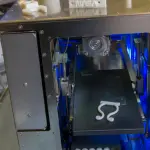How 3D printers will colonise Mars
3D PRINTING IN SPACE?
Every week, someone seems to find a new use for 3D printing here on Earth. The first 3D-printed parts have been certified for use in airliners, all sorts of medical prostheses for both humans and animals have been created, and there’s no shortage of printed phone case and e-cigarette designs floating around the internet. But could 3D printing be the technology that really opens up space?
So far, manned space missions have mostly been fairly short trips – and the one exception, the International Space Station, gets regular deliveries from supply rockets. If equipment needs spare parts they can be delivered within a few days, and the ISS crew don’t really need to make things for themselves.
That isn’t good enough for the next space goal, though. Sooner or later somebody is going to launch a mission to Mars, and that brings a whole new set of challenges. For a start, it takes a year to get there. If anything goes wrong on the way, the astronauts need to be able to fix it themselves – and that includes making new parts, if necessary. The ISS already has a 3D printer on board, to test how the technology works in zero gravity; any Mars mission will certainly have at least one and probably several.
Even 3D printing isn’t much of a solution when the mission reaches Mars, though. Any trip to the planet is likely to be a long one – and it might even, intentionally, be one-way. The moon missions only stayed on the surface for a few hours, but thanks to the orbital mechanics of Mars the astronauts would be there for at least 550 days before the planets were in the right alignment for them to set off on the return trip. That’s long enough for the supplies of printing materials they could carry with them to get severely depleted.
Now there’s a project underway to see if printer supplies can be made from Martian raw material. Scientists actually have samples of regolith – rock dust – from the moon, and rovers have sent back detailed information about the regolith on Mars (which is very different). A team at Northwestern University in Illinois have been running experiments using simulated regolith (both lunar and Martian) to see if they can print with it. It turns out that yes, they can.
What he scientists have done is mix 10% polymer binder with 90% unprocessed regolith to create a printable substance. The result is a flexible, plastic-like material that can be used for a lot of objects where strength isn’t vital – and because the raw material is dust that’s just lying around on Mars in huge quantities, there’s almost no limit to how much can be printed. The polymer they used comes from biological sources, so it’s likely that it could be grown from cell cultures during the mission, and the team have already looked at recycling methods for the other chemicals they used. With a little development, Mars colonists might be able to print as much as they like.
This has a lot of possibilities. One of the biggest challenges for colonists would be building a home for themselves. Spending 550 days – or longer – inside a cramped planetary lander would be rather dull, but the cost of sending construction materials into space would be mind-blowing. But what if the first thing they did was sieve a pile of regolith to get the lumps out, then set up an automated printer and tell it to start making bricks? They’d still be living in the lander for a few weeks, but eventually there would be enough bricks to start building a proper colony – and the printer would still be making more, to expand it.
If humans are going to spend long periods in space or on other worlds, one of the biggest challenges will be to get small-scale manufacturing started quickly enough for the colony to become self-sufficient. We’re already seeing how 3D printing can improve manufacturing on Earth; its effects will be even more dramatic on Mars.








Leave a comment
You must be logged in to post a comment.